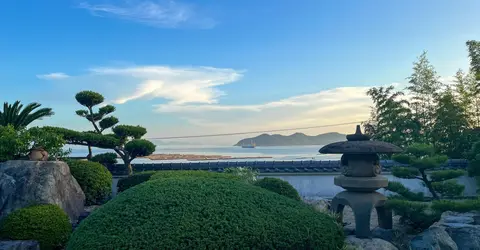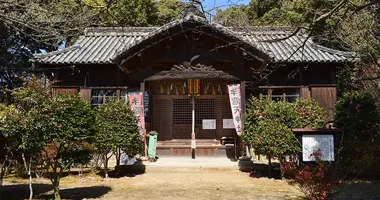Saidaiji Kannon-in Temple
Saidaiji Kannon-in Temple in Okayama is the venue for the annual Hadaka matsuri (Naked Festival) in February when 10,000 men compete to catch two wooden charms thrown into the throng.
Saidaiji Kannon-in Temple, Okayama 西大寺(観音院)
Jake Davies
There's nothing too unusual about a large open space within the grounds of a large temple, however such spaces are usually interspersed with paths and maybe some solitary trees or statues, but the space in front of the main hall of Saidaijikannon-in Temple in Okayama is just a vast expanse of packed earth.
The reason will be found on a night late in February when the space is filled with up to 10,000 almost-naked men and boys, because this is the site of the famous "Naked Festival", the Hadaka Matsuri, one of the "Three Strange Festivals of Japan".
 Saidaijikannon-in Temple in Okayama, home of the Naked Festival, one of the Three Strange Festivals of Japan.
Saidaijikannon-in Temple in Okayama, home of the Naked Festival, one of the Three Strange Festivals of Japan. The shutters to one of the shops on the street approaching Saidaijikannon-in Temple painted with a scene from the Naked Festival - Hadaka Matsuri
The shutters to one of the shops on the street approaching Saidaijikannon-in Temple painted with a scene from the Naked Festival - Hadaka Matsuri
Hadaka Festival (Naked Festival)
Ceremonial preparation begins in early February, but the festival itself takes place on the 3rd Saturday of February.
In the afternoon a smaller version of the event is held for very young boys, and then in the evening two troupes of female taiko drummers perform, but the main event happens at 10pm by which time upwards of 9,000 men of all ages dressed only in fundoshi have assembled in front of the main hall in the cold night air.
The lights go out suddenly and the priests toss bundles of willow sticks and two small wooden ofuda out into the crowd. Catching and keeping one of the 100 willow sticks is said to bring good luck for the coming year - in fact it is said that simply taking part in the Hadaka matsuri will bring good fortune - but the real prize are the two wooden ofuda. Simply catching them is not enough, they must be taken and placed in a small wooden box, and all the while the other 9,000 men are going to do their best to take it from you. Overt violence is not allowed - no kicking, punching, etc, but anything else goes and in some ways the scene resembles a rugby scrum or American Football match with no teams but 9,000 players.
Eventually two men end up placing the ofuda in the box and are then hailed as "Lucky man". Special grandstands are constructed for the event but tickets sell out well in advance and are very hard to come by. Hadaka matsuri take place at numerous sites but the one at Saidaijikannon-in is the original on which all others are based and dates back 500 years.
 An Ema (votive plaque) from Saidaijikannon-in Temple showing the Hadaka matsuri
An Ema (votive plaque) from Saidaijikannon-in Temple showing the Hadaka matsuri A one tenth scale copy of the famous 33 meter tall Fuda Nankai Kannon statue in China, a gift from China in 2003
A one tenth scale copy of the famous 33 meter tall Fuda Nankai Kannon statue in China, a gift from China in 2003
History
The origins of the temple lie in the mid-8th century with a noblewoman named Minato Fujiwara who lived far to the west in what is now Yamaguchi Prefecture.
She was a fervent believer in Kannon, and her greatest desire was to have a statue of Kannon, but was unable to find anyone who could carve one for her.
One evening a traveller came to her door and asked for a place to stay the night. He wouldn't give his name but said he was a woodcarver from Hasedera, an important temple near Nara that was a center of Kannon worship and at that time was the starting point of the Saigoku Kannon Pilgrimage, one of the oldest pilgrimages in Japan.
Unable to believe her luck she begged the man to carve a statue of Kannon for her, and he agreed but on the condition that he work in private and no-one must look into the room.
She agreed and all went well until one night she was walking down the corridor outside the room where he was working and she heard voices in conversation inside the room. She peeked in and saw the man talking with the statue. He saw her, became enraged and stormed off, but fortunately the statue was complete.
Minato managed to convince herself that the man had in fact been a manifestation of Kannon and so she resolved to take the statue to Hasedera Temple. Travel in those days was mostly by boat and she set off along the Inland Sea towards Nara.
At the time her husband was on official business in Bizen, the old name for what is now southern Okayama, and so she broke her journey there to visit with him. When it came time to depart and continue her journey a strange thing happened - the boat simply would not move, no matter what was tried it would not budge. Eventually the statue was unloaded and then suddenly the boat began to move. This was taken to be a sign that the Kannon statue wished to stay in this place, and so she had a small hut constructed to house the statue, and this then grew to be Saidaijikannon-in Temple.
 Shimmen gate constructed in 1819
Shimmen gate constructed in 1819 Three storey pagoda constructed in 1678
Three storey pagoda constructed in 1678
Access - Getting to Saidaijikannon-in Temple
Saidaijikannon-in Temple
8-8-3, Saidaijinaka, Higashi-ku, Okayama-shi, Okayama 704-8116
Tel: 0869 42 2058
The temple is a 20 minute walk directly south of Saidaiji Station on the JR Ako Line, about 20 minutes from Okayama Station.
 A smaller stone statue of a Kannon in the grounds of the Saidaijikannon-in Temple
A smaller stone statue of a Kannon in the grounds of the Saidaijikannon-in Temple















